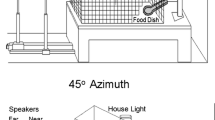Abstract
The boundary element method was used to calculate the sound pressure levels at the two ears of an artificial head when a sound source was located in different directions and distances in the near field (within 1 m). Total loudness was then calculated by using a binaural loudness model. Results showed that, in the near field, total loudness does not always increase monotonically as the source distance decreases. As distance decreased (for bands with center frequencies above 2 kHz), generally loudness first decreased and then increased (creating a local minimum); and when the distance became very small, the loudness generally began to decrease again (loudness had a local maximum). The external surface model of the artificial head was explored computationally. Calculations confirmed that the local minimum and maximum were caused by scattering from the shoulders. The effect of the width of the shoulders on near-field loudness was also determined. Finally, psychoacoustic experiments were conducted on four subjects. Results confirmed the presence of a local minimum and maximum and supported the idea that scattering from the shoulders was the main cause.










Similar content being viewed by others
References
Florentine, M.: Loudness. Springer, New York (2011)
Sivonen, V.P., Ellermeier, W.: Directional loudness in an anechoic sound field, head-related transfer functions, and binaural summation. J. Acoust. Soc. Am. 119(5 Pt 1), 2965 (2006)
Shaw, E.A.G.: Transformation of sound pressure level from the free field to the eardrum in the horizontal plane. J. Acoust. Soc. Am. 56(6), 1848–1861 (1974)
Wightman, F.L., Kistler, D.J.: Headphone simulation of free field listening. I: Stimulus synthesis. J. Acoust. Soc. Am. 85(2), 858–867 (1989)
Moller, H., Sorensen, M.F., Hammershoi, D., Jensen, C.B.: Head-related transfer functions of human subjects. J. Audio Eng. Soc. 43, 300–321 (1995)
Xie, B.: Head-related transfer function and virtual auditory display. Sci. China 39(9), 1268–1285 (2009)
Hammershoi, D., Moller, H.: Sound transmission to and within the human ear canal. J. Acoust. Soc. Am. 100(1), 408–427 (1996)
Xie, B.: Head-Related Transfer Function and Virtual Auditory Display. J. Ross Publishing, Florida (2013)
Sivonen, V., Ellermeier, W.: Binaural loudness. In: Florentine, M., Popper, A., Fay, R. (eds.) Loudness, pp. 169–197. Springer, New York (2011)
Moore, B.C.J., Glasberg, B.R.: Modeling binaural loudness. J. Acoust. Soc. Am. 121(3), 1604–1612 (2007)
Algazi, V.R., Duda, R.O., Duralswami, R., Gumerov, N.A., Tang, Z.: Approximating the head-related transfer function using simple geometric models of the head and torso. J. Acoust. Soc. Am. 112(1), 2053–2064 (2002)
Walsh, T., Demkowicz, L., Charles, R.: Boundary element modeling of the external human auditory system. J. Acoust. Soc. Am. 115(3), 1033 (2004)
Otani, M., Ise, S.: Fast calculation system specialized for head-related transfer function based on boundary element method. J. Acoust. Soc. Am. 119(5 Pt 1), 2589 (2006)
Xie, B., Yu, G.: Analysis on the transmission between free-field and binaural pressure levels for near-field sound source. In: Inter-Noise and Noise-Con Congress and Conference Proceedings (2013)
Katz, B.F.G.: Boundary element method calculation of individual head-related transfer function. I. Rigid model calculation. J. Acoust. Soc. Am. 110(5 Pt 1), 2440 (2001)
Katz, B.F.G.: Boundary element method calculation of individual head-related transfer function. II. Impedance effects and comparisons to real measurements. J. Acoust. Soc. Am. 110(1), 2449–2455 (2001)
Kahana, Y., Nelson, P. A., Petyt, M., Choi, S.: Numerical modeling of the transfer functions of a dummy-head and of the external ear. In: AES 16th International Conference, Rovaniemi, Finland (1999)
Moore, B.C.J., Glasberg, B.R., Baer, T.: A model for the prediction of thresholds, loudness, and partial loudness. J. Audio Eng. Soc. 45(4), 224–240 (1997)
Brungart, D.S., Rabinowitz, W.M.: Auditory localization of nearby sources. Head-related transfer functions. J. Acoust. Soc. Am. 106(3 Pt 1), 1465–1479 (1999)
Zahorik, P.: Auditory display of sound source distance. In: International Conference on Auditory Displays, pp. 326–32 (2002)
Kolarik, A.J., Moore, B.C.J., Zahorik, P., Cirstea, S., Pardhan, S.: Auditory distance perception in humans: a review of cues, development, neuronal bases, and effects of sensory loss. Atten. Percept. Psychophys. 78(2), 373–395 (2016)
Zahorik, P., Brungart, D.S., Bronkhorst, A.W.: Auditory distance perception in humans: a summary of past and present research. Acta Acust United Acust 91(3), 409–420 (2005)
Yu, G., Xie, B., Rao, D.: Effect of sound source scattering on measurement of near-field head-related transfer functions. Chin. Phys. Lett. 25(8), 2926 (2008)
Acknowledgements
The authors thank all listeners who participated in the experiments.
Author information
Authors and Affiliations
Corresponding author
Additional information
Publisher’s Note
Springer Nature remains neutral with regard to jurisdictional claims in published maps and institutional affiliations.
Rights and permissions
About this article
Cite this article
Chen, Z., Mao, D. Near-Field Variation of Loudness with Distance. Acoust Aust 47, 175–184 (2019). https://doi.org/10.1007/s40857-019-00158-1
Received:
Accepted:
Published:
Issue Date:
DOI: https://doi.org/10.1007/s40857-019-00158-1




